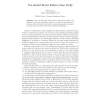Free Online Productivity Tools
i2Speak
i2Symbol
i2OCR
iTex2Img
iWeb2Print
iWeb2Shot
i2Type
iPdf2Split
iPdf2Merge
i2Bopomofo
i2Arabic
i2Style
i2Image
i2PDF
iLatex2Rtf
Sci2ools
RV
2010
Springer
2010
Springer
You Should Better Enforce Than Verify
This tutorial deals with runtime enforcement which is an extension of runtime verification aiming to circumvent misbehaviors of systems. After an historical overview of previous approaches, we present our approach to property enforcement and future challenges. Runtime verification is a well established technique which consists in using a monitor to supervise at runtime, the execution of an underlying program against a set of expected properties. A monitor is a state machine (with an output function) processing (step by step) an execution sequence of the monitored program, and producing a sequence of verdicts (truth values of a truth-domain) indicating fulfillment or violation of a property. Whilst the detection might sometimes be a sufficient assurance for some systems, the occurrence (resp. non-occurrence) of property violations (resp. validations) might be unacceptable for others. Runtime enforcement [1–4] of the desired property is a possible solution to ensure expected behavio...
| Added | 30 Jan 2011 |
| Updated | 30 Jan 2011 |
| Type | Journal |
| Year | 2010 |
| Where | RV |
| Authors | Yliès Falcone |
Comments (0)

